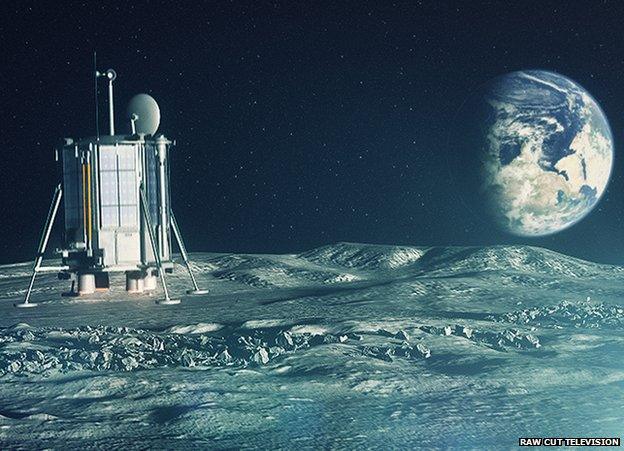UK researchers set out goals for Lunar Mission One
- Published
- comments

Lunar Mission One: to deeply drill where no one has drilled before
Scientists have set out the detailed scientific goals, external of a proposed UK-led mission to the Moon.
Its principal aim is to survey the Lunar South pole to learn more about the geology of the Moon and see if a human base can be set up in the future.
It will also drill 100 metres below the surface and also assess whether it is feasible to have observatories on the far side of the Moon.
Details of the Lunar Mission One programme were announced last month.
Its backers hope to raise the bulk of the £500m needed for the project from public donations. In return, donors will be able to send messages, pictures and even hair samples which will be buried under the lunar surface.
However its organisers say that the mission also has a serious scientific purpose. Although there have been more than 50 expeditions to the Moon including six landings by Apollo astronauts there is still much to learn, according to Prof Ian Crawford, who is one of Lunar Mission One's principle scientific advisers.
"Until recently the European Space Agency had plans for a lunar lander (which has since been scrapped) and the science case for Lunar Mission One is quite similar," he told BBC News. "In addition, we propose to have a drill so there will be new science too".
In particular there have been no missions to the Moon's south pole, which is particularly interesting because it is the site of the deepest known impact crater in our Solar System, around 12km deep. It's thought that it might contain rocks from tens of km below the surface and even part of the lunar mantle dug up by an impact more than four billion years ago.
The site is in effect a portal into the Moon's interior and its distant past.
This animation shows how scientists envisage the lander working on the moon
The deepest samples that have been obtained are from three metres below the surface, by Apollo 17 Astronauts Gene Cernan and Harrison Schmitt in 1972.
Lunar mission One aims to drill up to 100 metres below the surface of a site which is already thought to have material thrown up by a giant impact billions of years ago from several kilometres below the surface.
Apollo 17 astronaut Harrison Schmidt obtained Moon rock from 3 metres below the surface. No other mission has drilled deeper.
The study of the rock by the spacecraft's on board laboratory should give a unique insight into what happened during the early days of the formation of the Moon, and in particular what happened when it was torn away from the proto-Earth by a collision with another, now destroyed world called Theia when the planets of the Solar System had just formed.
It will also give an indication of the depth to which water might be present. Current studies have suggested that it is in surface soils near the pole - but it will need to be found much deeper if there is to be enough to support a human base. The analysis will also search for traces of organic (carbon) compounds which might have been reached the Moon by bombardment by meteorites.
Lunar Mission One will test the feasibility of using the site as a radio observatory. The virtue of the South pole is that it sometimes faces away from the Earth and so is shielded from the hubbub of our planet's constant broadcast transmissions.
Astronomers have long wondered whether an observatory on the far side of the Moon would be worthwhile. Such a telescope would be ideal for detecting signals of some of the earliest galaxies to form - currently a blind spot in astronomy.
- Published19 November 2014
- Published5 June 2014
